Related Research Articles
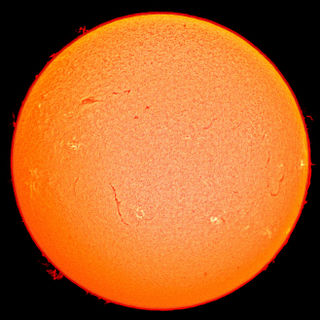
In physics, energy is the quantitative property that must be transferred to a body or physical system to perform work on the body, or to heat it. Energy is a conserved quantity; the law of conservation of energy states that energy can be converted in form, but not created or destroyed. The unit of measurement in the International System of Units (SI) of energy is the joule, which is the energy transferred to an object by the work of moving it a distance of one metre against a force of one newton.
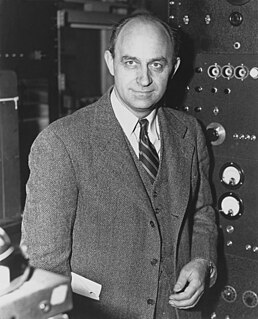
Enrico Fermi was an Italian physicist and the creator of the world's first nuclear reactor, the Chicago Pile-1. He has been called the "architect of the nuclear age" and the "architect of the atomic bomb". He was one of very few physicists to excel in both theoretical physics and experimental physics. Fermi was awarded the 1938 Nobel Prize in Physics for his work on induced radioactivity by neutron bombardment and for the discovery of transuranium elements. With his colleagues, Fermi filed several patents related to the use of nuclear power, all of which were taken over by the US government. He made significant contributions to the development of statistical mechanics, quantum theory, and nuclear and particle physics.
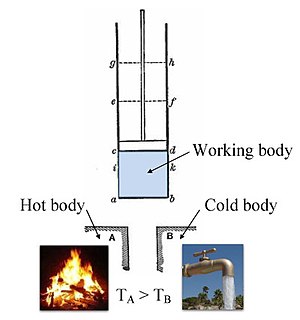
Thermodynamics is a branch of physics that deals with heat, work, and temperature, and their relation to energy, radiation, and physical properties of matter. The behavior of these quantities is governed by the four laws of thermodynamics which convey a quantitative description using measurable macroscopic physical quantities, but may be explained in terms of microscopic constituents by statistical mechanics. Thermodynamics applies to a wide variety of topics in science and engineering, especially physical chemistry, biochemistry, chemical engineering and mechanical engineering, but also in other complex fields such as meteorology.

A nuclear power plant is a thermal power station in which the heat source is a nuclear reactor. As is typical of thermal power stations, heat is used to generate steam that drives a steam turbine connected to a generator that produces electricity. As of 2018, the International Atomic Energy Agency reported there were 450 nuclear power reactors in operation in 30 countries around the world.
The Agenzia nazionale per le nuove tecnologie, l'energia e lo sviluppo economico sostenibile (ENEA) is an Italian Government-sponsored research and development agency. The agency undertakes research in areas which will help to develop and enhance Italian competitiveness and employment, while protecting the environment.
Howard Thomas Odum, usually cited as H. T. Odum, was an American ecologist. He is known for his pioneering work on ecosystem ecology, and for his provocative proposals for additional laws of thermodynamics, informed by his work on general systems theory.
In thermodynamics, the exergy of a system is the maximum useful work possible during a process that brings the system into equilibrium with a heat reservoir, reaching maximum entropy. When the surroundings are the reservoir, exergy is the potential of a system to cause a change as it achieves equilibrium with its environment. Exergy is the energy that is available to be used. After the system and surroundings reach equilibrium, the exergy is zero. Determining exergy was also the first goal of thermodynamics. The term "exergy" was coined in 1956 by Zoran Rant (1904–1972) by using the Greek ex and ergon meaning "from work", but the concept had been earlier developed by J Willard Gibbs in 1873.
In energy economics and ecological energetics, energy return on investment (EROI), also sometimes called energy returned on energy invested (ERoEI), is the ratio of the amount of usable energy delivered from a particular energy resource to the amount of exergy used to obtain that energy resource.
Emergy is the amount of energy that was consumed in direct and indirect transformations to make a product or service. Emergy is a measure of quality differences between different forms of energy. Emergy is an expression of all the energy used in the work processes that generate a product or service in units of one type of energy. Emergy is measured in units of emjoules, a unit referring to the available energy consumed in transformations. Emergy accounts for different forms of energy and resources Each form is generated by transformation processes in nature and each has a different ability to support work in natural and in human systems. The recognition of these quality differences is a key concept.
In 1996 H.T. Odum defined transformity as,
"the emergy of one type required to make a unit of energy of another type. For example, since 3 coal emjoules (cej) of coal and 1 cej of services are required to generate 1 J of electricity, the coal transformity of electricity is 4 cej/J"

Energy quality is a measure of the ease at which a form of energy can be converted to useful work or to another form of energy. A high quality form of energy is easily converted to work or to a lower quality form of energy, whereas converting low quality forms of energy to work or a higher quality form may be inefficient, difficult or impossible. The concept of energy quality is also used in ecology, where it is used to track the flow of energy between different trophic levels in a food chain and in thermoeconomics, where it is used as a measure of economic output per unit of energy. Methods of evaluating energy quality often involve developing a ranking of energy qualities in hierarchical order.

The maximum power principle or Lotka's principle has been proposed as the fourth principle of energetics in open system thermodynamics, where an example of an open system is a biological cell. According to Howard T. Odum, "The maximum power principle can be stated: During self-organization, system designs develop and prevail that maximize power intake, energy transformation, and those uses that reinforce production and efficiency."
David M. Scienceman is an Australian scientist; he changed his name from David Slade by deed poll in 1972. McGhee (1990) wrote that his change of name from Slade to Scienceman was an experiment to create a movement of scientifically aware politicians. In a world dominated by scientific achievements and problems, Slade believed that there should be a political party that represented the scientific point of view.
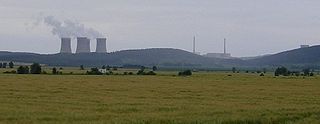
The Mochovce Nuclear Power Plant is a nuclear power plant located between the towns of Nitra and Levice, on the site of the former village of Mochovce, Slovakia. Two up-rated 470 MW reactors are presently in operation, with two further reactors of the same type under construction. Generating almost 7,000 GWh of electricity a year, the power plant currently serves approximately 20% of Slovakia's electricity needs.

Nuclear power in Italy is a controversial topic. Italy started to produce nuclear energy in the early 1960s, but all plants were closed by 1990 following the Italian nuclear power referendum. As of 2018, Italy is one of only two countries, along with Lithuania, that completely phased out nuclear power for electricity generation after having operational reactors.
Sustainability metrics and indices are measures of sustainability, and attempt to quantify beyond the generic concept. Though there are disagreements among those from different disciplines, these disciplines and international organizations have each offered measures or indicators of how to measure the concept.
Energy technology is an interdisciplinary engineering science having to do with the efficient, safe, environmentally friendly, and economical extraction, conversion, transportation, storage, and use of energy, targeted towards yielding high efficiency whilst skirting side effects on humans, nature, and the environment.
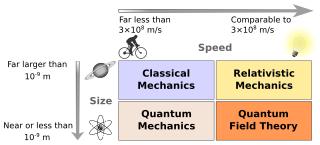
Physics is a scientific discipline that seeks to construct and experimentally test theories of the physical universe. These theories vary in their scope and can be organized into several distinct branches, which are outlined in this article.

Nuclear Power School (NPS) is a technical school operated by the U.S. Navy in Goose Creek, South Carolina to train enlisted sailors, officers, KAPL civilians and Bettis civilians for shipboard nuclear power plant operation and maintenance of surface ships and submarines in the U.S. nuclear navy. NPS is the centerpiece of the training pipeline for US Navy nuclear operators. It follows initial training at Nuclear Field "A" School or a college degree, and culminates with certification as a nuclear operator at one of the Navy's two Nuclear Power Training Units (NPTU). As of 2020, since training the crew of the first nuclear powered vessel, the USS Nautilus, in 1952 the Program has trained and qualified over 142,000 nuclear propulsion plant operators. Also as of 2020, the United States Navy operates 98 nuclear power plants, including 71 submarines, 11 aircraft carriers, and 5 Moored Training Ships (MTS) and land-based training plants. Since 1955 when USS Nautilus first got underway on nuclear power, Navy nuclear powered vessels have safely steamed over 166 million miles.
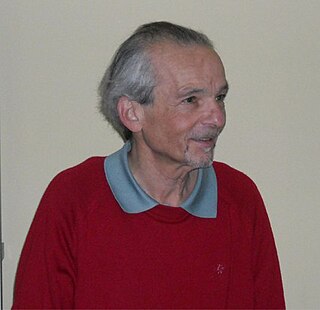
Bernard Howard Lavenda is a retired professor of chemical physics at the University of Camerino and expert on irreversible thermodynamics. He has contributed to many areas of physics, including that of Brownian motion, and in the establishment of the statistical basis of thermodynamics, and non-Euclidean geometrical theories of relativity. He was the scientific coordinator of the "European Thermodynamics Network" in the European Commission Program of Human Capital and Mobility. He was also a proponent for the establishment of, and scientific director of, a National (Italian) Centre for Thermodynamics, and has acted as scientific consultant to companies such as the ENI Group, where he helped to found TEMA, a consulting firm for SNAM Progetti, ENEA, and the Solar Energy Research Institute in Golden, Colorado. He has had over 130 scientific papers published in international journals, some critical of the new fashions and modes in theoretical physics.
References
- C.Giannantoni (2000) 'Toward a Mathematical Formulation of the Maximum Em-Power Principle', in M.T.Brown (ed.) Emergy Synthesis: Theory and applications of the emergy methodology, Proceedings from the first biennial emergy analysis research conference, The Center for Environmental Policy, Department of Environmental Engineering Sciences, University of Florida, Gainesville, FL.
- C.Giannantoni (2002) The Maximum Em-Power Principle as the basis for Thermodynamics of Quality, Servizi Grafici Editoriali, Padova.
- C.Giannantoni (2006) 'Mathematics for generative processes: Living and non-living systems' Journal of Computational and Applied Mathematics 189, pp. 324–340
- C.Giannantoni, C. Cialanib and A. Mansueti (2002) Analysis of investments based on the trilateral externality approach (firm, citizen, state), Ecological Indicators, Volume 2, Issues 1-2, November 2002, Pages 27–38. doi : 10.1016/S1470-160X(02)00051-1